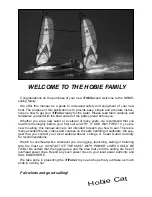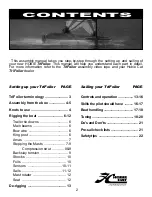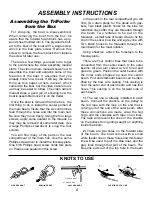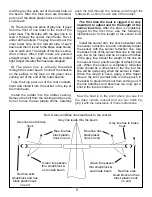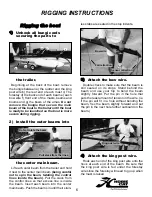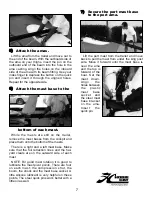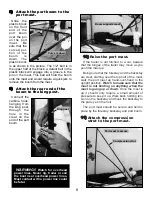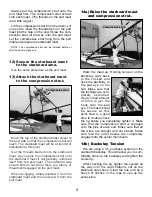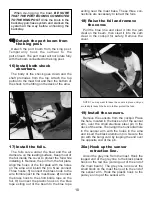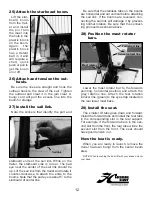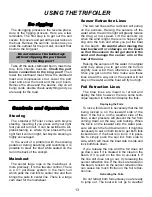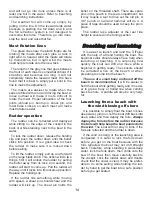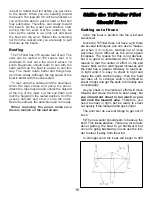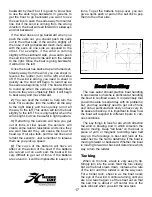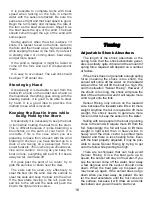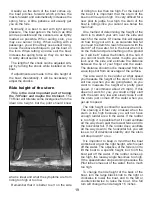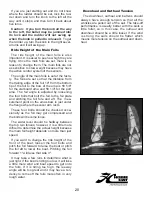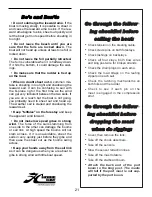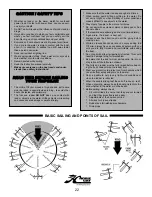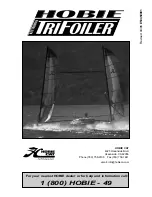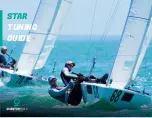
Launching from a beach with
the wind blowing on-shore
This is very easy with two people, but may
be difficult solo. It is important to get all three
foils locked down before you get into the boat.
It should be easy to lock down both foils while
the boat is pointed into the wind by using the
sail link to move the boat from side to side. It is
important to keep the boat pointed into the
wind.
Refer to the section (pg. #18) on keeping
the boat pointed into the wind while standing at
the back of the boat
. After the foils are locked
down, lock the rudder down.
When you are ready to go, let the bow of the
boat point away from the wind slightly, sheet in
a little and let the boat start to sail. The tricky
part is that you must keep some tension on the
mainsheet, a hand on the rudder and jump into
the boat at the same time. If you let go of the
sheet or the rudder, the boat will round up into
the wind and you may have to start over. If you
let the boat round up into the wind, you may
not be able to get it out of irons before drifting
back onto the beach.
There are a couple of ways to do this. One is
to use the traveler line (white nylon line con-
nected to the center of the sail link) to sheet
the sails in while lying on your stomach on the
back of the boat and steering with one hand.
Once the boat picks up some speed, you may
take your hand off the rudder for a little while to
get more comfortable, but sail out about 100
yards or so before you get seated in the cock-
pit.
Launching from a beach with a
side-shore breeze
This situation should be handled the same as
if the wind were blowing on-shore except that it
is not as important to get both foils down. It is
important to get at least the leeward foil and
rudder down. Use the same technique to jump
on as described above for launching with an
on-shore breeze. Once you get out on the
water you can go into irons, get seated and get
the weather foil down.
Beaching with the wind blowing
off-shore
The TriFoiler will not sail upwind with the foils
retracted; therefore, it is necessary to sail in
close with the sensors retracted and the foils
down until you know the water is shallow
enough to get out (But not so deep that your
will not be able to hold the boat). If the shore is
steep, sail slowly until you feel the foils touch
bottom. If the shore is steep and rocky, you
should have help on shore to prevent damage
to the boat.
Once you are standing on the beach, go to
the back of the boat and raise the rudder while
keeping the boat pointed into the wind. When
the rudder is up, move to each ama and raise
each foil using the cleat on the beam to lock
up each foil. When the foils are retracted, the
boat can be pulled up the beach.
Beaching with the wind blowing
on-shore
If the wind is light, it is possible to retract the
foils out on the water and sail the boat right up
the beach. Retract the foils and sensors out on
the water. Sit on the rail in the back and steer
the boat by hand. When nearing the beach,
unlock the rudder and raise it up part way.
Before the rudder touches bottom, and lock
the rudder up and let the boat drift into the
beach.
If the wind is strong, it is necessary to turn the
boat into the wind and let it drift backward onto
the beach with the foils up. It is surprising how
fast the boat will drift backward, so put the boat
into irons off-shore and then pull up the rudder.
Be sure that the boat is straight into the wind. If
you raise the foils and the boat is not straight
into the wind, it may drift sideways more than
back. Be sure to raise the rudder before the
foils. If you raise the foils before raising the rud-
der, the boat may not stay in irons.
With the foils and rudder up, let the boat drift
back into shallow water
(be sure that the
water is not too deep and never let go of
the boat)
and hop out. Be aware and keep the
boat pointed into the wind. Then pull the boat
up the beach.
Beaching with a side-
shore breeze
This is similar to beaching with an off-shore
breeze, but it helpful to retract the foil that will
be closest to the beach when the boat is point-
ed into the wind. This will allow you to get clos-
er to the beach without the foil hitting bottom. It
15
Summary of Contents for TriFoiler
Page 1: ...ASSEMBLY MANUAL...

